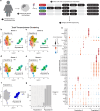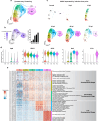scRNA-seq uncovers the transcriptional dynamics of Encephalitozoon intestinalis parasites in human macrophages
- PMID: 40188181
- PMCID: PMC11972355
- DOI: 10.1038/s41467-025-57837-z
scRNA-seq uncovers the transcriptional dynamics of Encephalitozoon intestinalis parasites in human macrophages
Abstract
Microsporidia are single-celled intracellular parasites that cause opportunistic diseases in humans. Encephalitozoon intestinalis is a prevalent human-infecting species that invades the small intestine. Macrophages are potential reservoirs of infection, and dissemination to other organ systems is also observed. The macrophage response to infection and the developmental trajectory of the parasite are not well studied. Here we use single cell RNA sequencing to investigate transcriptional changes in both the parasite and the host during E. intestinalis infection of human macrophages in vitro. The parasite undergoes large transcriptional changes throughout the life cycle, providing a blueprint for parasite development. While a small population of infected macrophages mount a response, most remain transcriptionally unchanged, suggesting that the majority of parasites may avoid host detection. The stealthy microsporidian lifestyle likely allows these parasites to harness macrophages for replication. Together, our data provide insights into the host response in primary human macrophages and the E. intestinalis developmental program.
© 2025. The Author(s).
Conflict of interest statement
Competing interests: The authors declare no competing interests.
Figures






Update of
-
scRNA-seq reveals transcriptional dynamics of Encephalitozoon intestinalis parasites in human macrophages.bioRxiv [Preprint]. 2024 May 30:2024.05.30.596468. doi: 10.1101/2024.05.30.596468. bioRxiv. 2024. Update in: Nat Commun. 2025 Apr 05;16(1):3269. doi: 10.1038/s41467-025-57837-z. PMID: 38853846 Free PMC article. Updated. Preprint.
Similar articles
-
scRNA-seq reveals transcriptional dynamics of Encephalitozoon intestinalis parasites in human macrophages.bioRxiv [Preprint]. 2024 May 30:2024.05.30.596468. doi: 10.1101/2024.05.30.596468. bioRxiv. 2024. Update in: Nat Commun. 2025 Apr 05;16(1):3269. doi: 10.1038/s41467-025-57837-z. PMID: 38853846 Free PMC article. Updated. Preprint.
-
3D reconstructions of parasite development and the intracellular niche of the microsporidian pathogen Encephalitozoon intestinalis.Nat Commun. 2023 Nov 23;14(1):7662. doi: 10.1038/s41467-023-43215-0. Nat Commun. 2023. PMID: 37996434 Free PMC article.
-
[Evaluation of the reproductive potential of Encephalitozoon intestinalis in four different cell line].Mikrobiyol Bul. 2018 Oct;52(4):390-400. doi: 10.5578/mb.67383. Mikrobiyol Bul. 2018. PMID: 30522424 Turkish.
-
[Encephalitozoon cuniculi and Encephalitozoon intestinalis--causes of opportunistic infections].Epidemiol Mikrobiol Imunol. 2002 Feb;51(1):26-32. Epidemiol Mikrobiol Imunol. 2002. PMID: 11881297 Review. Czech.
-
Innate immune responses to Encephalitozoon species infections.Microbes Infect. 2009 Oct;11(12):905-11. doi: 10.1016/j.micinf.2009.06.004. Epub 2009 Jun 30. Microbes Infect. 2009. PMID: 19573618 Review.
Cited by
-
Advances in Single-Cell Sequencing for Infectious Diseases: Progress and Perspectives.Adv Sci (Weinh). 2025 Aug;12(32):e15678. doi: 10.1002/advs.202415678. Epub 2025 Jul 4. Adv Sci (Weinh). 2025. PMID: 40613694 Free PMC article. Review.
References
-
- Tamim El Jarkass, H. & Reinke, A. W. The ins and outs of host-microsporidia interactions during invasion, proliferation and exit. Cell. Microbiol.22, e13247 (2020). - PubMed
MeSH terms
Grants and funding
LinkOut - more resources
Full Text Sources

